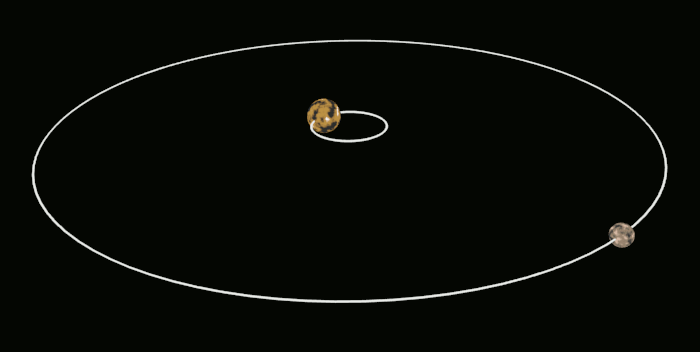10 Facts That Make Pluto worth Obsessing Over

Here on Travel Thru History, we have close ties to the celestial body known as Pluto. We featured its discovery at the Lowell Observatory on our Flagstaff show. This month, we lived through an event so historically important that we knew we had to write about it. New Horizons made it to Pluto, took some up close photos of the dwarf planet with a massive cult following, and sent them back to us. Jaws dropped, remarkable coincidences made us laugh or gawk, and that icy little lump of rock wormed its way further into our collective consciousness. Go Pluto – it’s got one thing most other bodies in our solar system can’t claim. The “it” factor.
Pluto’s status as a cultural icon isn’t surprising. It’s an amazing (albeit tiny) place. We’ve dug up the dirt on this Kuiper Belt Object, and you’re sure to be amazed by what I learned…

New Horizons. The little probe that could. Photo via wikipedia.
You can call it your favorite mistake.
Pluto’s discovery was based on bad math. Errors in the calculation of Uranus and Neptune’s orbits gave astronomers the impression that a mysterious “Planet X” had to be exerting an influence on the gravity of those well-known planets.
Astronomers like Percival Lowell and William H. Pickering spent years looking for that mystery planet. Neither found Pluto. An untrained amateur astronomer Clyde Tombaugh did, though…and Lowell probably groaned in his grave at the discovery. It only took Tombaugh a few months to find the ‘planet’ Lowell had chased for years.

Clyde Tombaugh in 1928. Photo via wikipedia.
Pluto is a lot of things to a lot of people – dwarf planet, binary planet, Kuiper Belt Object…
There are plenty of things that make Pluto unique, and apart from its status as the most popular Kuiper Belt Object (KBO), it holds a lot of titles that make it equally intriguing for scientists. It’s a dwarf planet, meaning that it is significantly smaller than the hard rocky planets like Earth and Mars that we find closer to the sun, and it’s laughably small when compared to the gas giants (think Jupiter).
Dwarf Planets. Photo via wikipedia.
Pluto’s bizarre planet-moon relationship with its largest satellite, Charon, makes it a fun object to study, too. Charon is almost as big as Pluto. The composition of the two appears to be very different, though. Charon and Pluto are both Kuiper Belt Objects, members of the third zone of our solar system. The Kuiper Belt is packed with tiny asteroids, icy dwarf planets, and other bodies like the ones that created the planet we live on and its neighbors. They just couldn’t keep it together long enough to form planets themselves.
Pluto’s a popular place. So popular, in fact, that it has five moons.
If Pluto had to list a Facebook status, I’m pretty sure it would say “It’s Complicated.” Charon isn’t the only moon hanging around with Pluto. This KBO has five moons – Charon, Styx, Hydra, Nix, and Kerberos.

Charon, one of Pluto’s moons. Photo via Wikipedia.
It’s the only object in our solar system with tons of smaller ones named after it. Plutinos are just the cutest little KBOs!
Plutinos are real. These “little Plutos” share a few common characteristics. They’re Kuiper Belt Objects, are planet-like in many ways, and they orbit the Sun in resonance with the planet Neptune. Pluto does that, too, by the way.
Carbon dioxide, nitrogen, methane, and … atmosphere.
Atmospheres in the Kuiper Belt aren’t very common. Many of the objects out there may have had them, but astronomers believe the majority have frozen over. Pluto’s may do the same in a few short decades, as it moves further away from the sun. In the meantime, however, it has an atmosphere – and a very interesting one, too.
Already, scientists have identified the presence of carbon dioxide, nitrogen, and methane in Pluto’s atmosphere. Those might sound like chemicals you need for life, but keep in mind the temperature. Even though there’s a theoretical probability that there’s plenty of water ice on this tiny body, it’s just too cold. Unless you’ve got a parka rated for 33K, I’d skip visiting, too.
Think glaciers and icebergs are pretty? Imagine ice mountains.
There’s one reason I might contemplate a trip to Pluto – even if it was a one way journey into the deep, took nine long years, and ended in a frigid demise in the nether regions of our solar system.
Ice mountains.
Imagine peaks as tall as the Rockies, jagged, young, and undeniably beautiful. Pluto has them. And if that’s not enough, make the atmosphere thin enough that you could easily bound up those peaks, enjoy the view, and run back down without getting winded.
Sound amazing, doesn’t it? Of course, it might just be easier to send a rover with a great camera…
Hearts, whales, and cartoon dogs…
Earth is covered in structures, and we keep looking for interesting shapes in space. As kids, we stare up at the sky and imagine what the clouds look like. A few people think they see pyramids or faces on Mars, too. But Pluto is a place we never expected to see thing on…it was the ice world. The equivalent of Star Wars’ planet Hoth. And yet, we’ve found a giant heart, a whale, and even the profile of Disney’s Pluto on the dwarf planet’s face.
There’s one uncanny image that science fiction fans couldn’t easily shake when they saw it, though. In 1979, one artist made a painting of Pluto that is shocking viewers today. The resemblance to the real planet is mind-boggling, including the odd color palette he chose for the body that most people argued was an ice cube. Don Dixon, the artist, is as shocked as the rest of the world by the similarity. I just think it’s cool.
It’s complicated, but not overly-dramatic.
The surface topography of Pluto is more complex than any other body in the solar system we’ve visited. There are mountains, plains, winds and snow…active geomorphology. It’s a captivating place that’s making many scientists stand back, jaws agape. But Pluto keeps its cool.

Pluto and Charon as pictured by New Horizons. Photo via Wikipedia.
Some scientists think that the features on the dwarf planet’s surface may be as young as 100 million years. Water is thought to drive much of the geomorphology on the planet, along with seasonal thaws, but Pluto’s wild surface features are peaking researchers’ curiosity.
The only real drama surrounding this planet-like object is about its demotion from planet to dwarf planet in 2006 by the International Astronomical Union. Not all scientists agree, and the majority of the general public still calls Pluto a planet. The features of Pluto are undeniably amazing, and it offers plenty to capture the imagination and keep scientists mulling over data for years. Size-wise, however, it doesn’t measure up.
Pluto orbits sideways.
And so does its satellite, Charon. They’ve got some other fun characteristics, too. They share the same length of “day” – 6.5 Earth days. The same side of Charon always faces Pluto, and Charon appears to constantly face the same part of Pluto.

Pluto-Charon Orbit. Photo via Wikipedia.
It knows how to take a load off.
If you thought laying around on its side made Pluto laid back, think again. I think it just makes it lazy, and there’s proof. Pluto doesn’t carry it’s center of gravity where most of us do. It just leaves it hanging around in space, somewhere between itself and Charon. Sure, that might look like teamwork to you, but did anyone ask Charon?
And as budding physicist Eric Mayotte reminded me, “From the time it was discovered as a planet to when it was demoted to dwarf planet, it didn’t make one full revolution around the sun. One Plutonian year is 248 years!”
So go on, indulge that Pluto obsession. It looks like that little rock earned your admiration after all! If you’d like to learn more about our most-famous Kuiper Belt neighbor, check out the New Horizon Mission’s Pluto page.








